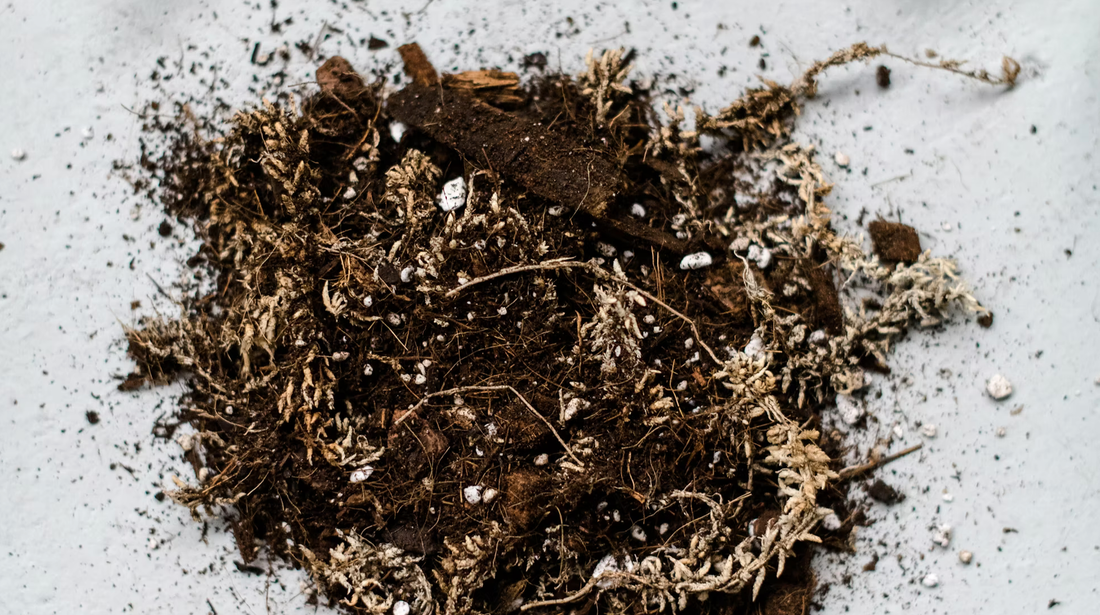Potting Mix, Substrate, and Soil: What Your Houseplants Really Need to Thrive
If you’ve ever asked "what kind of soil does this plant need?"—you’re not alone. Choosing the right potting mix or substrate is one of the most important (and most confusing) parts of plant care.
Walk into any greenhouse or garden center, and you’ll see bags labeled cactus mix, orchid blend, aroid soil, substrate, bonsai mix… but what do they all mean? And more importantly—how do you know which one your plant actually needs?
In this guide, we’ll break down everything you need to know about soils, potting mixes, and substrates for houseplants, including:
-
The difference between soil, potting mix, and substrate
-
Which types of plants prefer which types of growing media
-
Pros and cons of commonly used ingredients
-
Common myths about drainage and repotting
-
A breakdown of the high-quality blends we carry in our greenhouse
Let’s dig in.

What’s the Difference Between Potting Mix, Substrate, and Soil?
Potting Mix
Potting mix is a soilless medium designed specifically for container-grown plants. It’s typically made from a blend of organic and mineral materials like peat, coir, bark, perlite, and compost. These ingredients work together to provide:
-
Proper drainage
-
Oxygen at the root zone
-
Water retention without waterlogging
Most indoor tropicals, aroids, and general houseplants thrive in the right potting mix.
Substrate
Substrate refers to any individual material used to grow plants—either on its own or mixed into a potting blend. Common substrates include:
-
LECA (lightweight expanded clay aggregate)
Substrates are often used in semi-hydro setups, custom soil recipes, or for plant types with very specific root needs (like orchids or bonsai).
Soil or Garden Soil
Topsoil, outdoor garden soil and all purpose soils are not recommended for indoor plants. It’s dense, poorly draining, and can introduce pests or pathogens. Always use a specialty potting mix or indoor blend for houseplants.
Why Soil Choice Matters for Houseplants
Your plant’s roots need more than just moisture. They need airflow, nutrients, and space to grow without drowning. The wrong soil can cause:
-
Root rot
-
Slow or stunted growth
-
Pest or fungus problems
-
Compacted roots and suffocation
Different plants evolved in different conditions, which is why not all houseplants should be treated the same. A succulent from the desert doesn’t want the same mix as a rainforest aroid.
What Are the Most Common Potting Mix Ingredients?
Here’s a quick overview of popular potting mix and substrate components, and what they do:
| Ingredient | What It Does |
|---|---|
| Coco Coir | Lightweight, retains moisture, sustainable alternative to peat |
| Perlite | Improves aeration and drainage, keeps soil loose |
| Pumice | Adds drainage and air flow, doesn’t break down over time |
| Bark (Fir/Pine) | Adds chunky texture and structure, great for root aeration |
| Charcoal | Absorbs excess moisture and toxins, keeps soil fresh |
| Worm Castings | Organic nutrient source, supports soil microbes |
| Sphagnum Moss | Retains moisture evenly, supports rooting and disease resistance |
| LECA | Used in semi-hydroponics, holds moisture without compacting |
| Akadama/Hyuga | Hard clay particles used in bonsai and succulent blends |
| Biochar | Buffers pH, improves nutrient retention and microbial life |
Which Soil or Substrate Should I Use for My Plants?
Here’s a simple way to think about it:
| Plant Type | What It Likes |
|---|---|
| Aroids (Monstera, Philodendron, Alocasia) | Chunky, airy mix with organic and mineral matter |
| Succulents & Cacti | Fast-draining, gritty blend with pumice, sand, akadama |
| Orchids | Airy, bark-based substrate with moisture retention |
| Bonsai | Structured mix that drains fast but retains some moisture |
| General Houseplants | Balanced mix with light moisture retention and drainage |
| Semi-hydro setups | Inert substrate like LECA, pon, or moss + fertilizer support |
Our Soil & Substrate Lineup: Trusted by Jungle Junkies & Minimalists Alike
Molly’s Aroid Mix
For aroids like monstera, alocasia, philodendron, and anthuriums.
Ingredients: Coir fiber, coarse horticultural perlite, expanded clay, coir chips, horticultural charcoal, Rhizophagus irregularis, worm castings, fir bark, and Rhizobacteria (Bacillus pumilus).
Why it works: It offers excellent structure, pH balance, drainage, and a bioactive root zone for lush tropicals.
Molly’s Succulent Mix
For succulents, cacti, and caudex plants.
Ingredients: Akadama, orchid bark (fir), lava rock, Hyuga, pumice stone, mycorrhizae, Rhizobacteria
Why it works: High drainage and mineral content mimic arid environments to reduce rot and keep roots firm.
Molly’s Orchid Mix
For orchids, hoyas, and other epiphytic species.
Ingredients: Coco chips, orchid bark (fir), akadama, hyuga, lava rock, pumice, mycorrhizae, Bacillus pumilus
Why it works: Nutrient-rich and highly breathable—ideal for roots that need airflow and intermittent moisture.
Maya Growing Mediums Aroid Mix
For collectors and advanced aroid growers.
Ingredients: Coco coir, coco chips, fir bark fines, fine and coarse perlite, fir bark, pine bark, sphagnum moss, charcoal bits, worm castings, biochar, Phos-Pillar
Why it works: Highly textured, moisture-balancing, and microbially active. A next-level mix for healthy, robust root systems.
Maya Growing Mediums General Mix
Great for tropicals, foliage plants, calatheas, and ferns.
Ingredients: Coco coir, coco chips, fir bark fines, perlite, worm castings, biochar, Phos-Pillar
Why it works: Holds moisture without going soggy. Encourages gentle root feeding and long-term soil health.
Maya Cactus Blend
Tailored for desert dwellers.
Ingredients: Bio-charcoal, charcoal bits, coarse perlite, coco chunks, garden sand, fir bark fines, sea minerals, worm castings
Why it works: Ultra-gritty with essential trace minerals for strong, drought-tolerant plants.
Maya Growing Mediums Orchid Blend
For epiphytes and showy orchids.
Ingredients: Bio-charcoal, calcium, charcoal bits, coarse perlite, coco chunks, phosphorus, pine & fir bark fines, sphagnum moss, worm castings
Why it works: Offers air porosity, slow nutrient release, and excellent structure for aerial roots.
Maya Bonsai Blend
For bonsai and structured plants with delicate root systems.
Ingredients: Calcinated clay, charcoal bits, fir bark fines, Maya General Mix, medium pumice
Why it works: Moisture-managed and structured for long-term bonsai health and development.
Common Soil & Substrate Questions
What’s the best potting mix for houseplants?
Most tropical houseplants thrive in a general mix that retains moisture without becoming soggy. Our Maya General Mix is perfect for that balance.
Can I use sand or rocks in the bottom of my pots?
No. This old advice can actually cause water to sit on top of the rocks, increasing the risk of root rot. Always choose a well-draining mix and have pots and planters with good drainage instead of layering.
What’s the difference between perlite and pumice?
Both improve drainage, but pumice is heavier and won’t float. Perlite is lighter and more affordable but can compact or shift over time.
Do substrates need fertilizer?
Yes. Inert substrates like LECA, pumice, or moss don’t have nutrients—so you’ll need to supplement with a quality fertilizer or root booster. Read more about fertilizers and what fertilizers are best for your houseplant here.
Final Thoughts: Your Soil Matters More Than You Think
If you’ve struggled with root rot, fungus gnats, slow growth, or weird yellow leaves—your soil might be the problem. Switching to a better potting mix or building your own substrate-based system can make a massive difference.
Whether you're keeping things simple or diving into semi-hydro and custom blends, we carry everything you need—pre-mixed, tested, and designed to help your plants thrive.
Shop our full selection in-store or online. We ship across Canada, so you’re never too far from better dirt.
Need help choosing the right mix? Talk dirt to us. We’re always happy to help you match your plant to the perfect potting partner.




